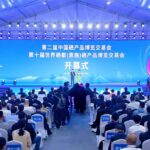Aerial view of the Yellow Crane Tower.
A cross-border e-commerce China-Europe freight train (Wuhan) is about to depart for Małaszewicze, Poland.
The “Huahang Hanya 5” ship docked at Yangluo Port.
On August 5, the CCID Consulting Urban Economic Research Center released the “2025 China Urban District High-Quality Development Research Report” (hereinafter referred to as the “Report”), along with the 2025 National Top 100 Districts ranking. Wuhan had eight districts on the list, ranking first in central China and second nationwide.
The eight districts are Wuchang District (40th), Hannan District (61st), Jianghan District (68th), Dongxihu District (71st), Jiang’an District (77th), Hongshan District (79th), Jiangxia District (81st), and Huangpi District (90th). Nationally, the top five cities with the most districts on the list are Chengdu (9), Wuhan (8), Guangzhou (7), Shenzhen (6), and Hangzhou (6). Yiling District (92nd) and Xiling District (94th) of Yichang City in Hubei also made the list.
Hubei’s 10 districts maintained their positions from last year, with six districts improving their rankings. Wuchang District rose from 41st to 40th, Hannan District from 70th to 61st, Jiang’an District from 79th to 77th, Huangpi District from 92nd to 90th, Yiling District from 96th to 92nd, and Xiling District from 98th to 94th.
The “Report” highlighted Wuchang District as a case study, analyzing new trends in top districts during the “15th Five-Year Plan” period: service-oriented manufacturing and industrial internet platforms will deeply empower district enterprises, driving development from scale expansion to high-value chain refinement.
Wuchang District leverages the Huawei (Wuhan) AI Innovation Center to provide SMEs with full-process services (diagnosis-renovation-acceptance), acting as a “smart engine” for reshaping industrial value chains. Additionally, the district promotes market-oriented data utilization, launching China’s first housing management data product, “Shouyi Smart Housing Insights,” on Hubei’s data trading platform to optimize services like elderly care and food delivery. Wuchang has also established a unified district data pool, opening 270 public data resources to support applications in smart security and education, expanding the data industry market.
CCID Consulting, under the Ministry of Industry and Information Technology, is a leading economic research institution. The Top 100 Districts evaluation maintained dual thresholds (GDP > ¥80 billion, general public budget revenue > ¥2 billion), assessing five indicators: economic strength, growth momentum, endogenous support, regional influence, and shared development.
The top ten districts were Nanshan District (Shenzhen), Futian District (Shenzhen), Tianhe District (Guangzhou), Bao’an District (Shenzhen), Longgang District (Shenzhen), Huangpu District (Guangzhou), Shunde District (Foshan), Wujiang District (Suzhou), Nanhai District (Foshan), and Wujin District (Changzhou).
22.3% – Wuhan’s foreign trade growth rate, ranking first among sub-provincial-level cities.
“Joining Wuhan Commerce Bureau’s ‘group出海’ delegation to Thailand’s first Agricultural Machinery Expo was highly rewarding! We secured $500,000 in意向 orders and initiated two tech collaborations with Thai agricultural firms,” said Jiang Zhiping, head of Hubei Nongke Runpu Eco-Technology Co., Ltd., upon returning from Thailand on August 5.
This was the company’s first overseas exhibition. Organized by the Wuhan Commerce Bureau, it saved nearly ¥100,000 in costs and facilitated talks with Thai authorities and companies like CP Group.
As Wuhan firms expand globally, their international presence grows. In H1 2024, Wuhan’s foreign trade reached ¥214.27 billion, up 22.3% – the fastest growth among 19 major Chinese cities.
Export structures are shifting from traditional manufacturing to high-value sectors. Strong exports of mobile phones (↑4.7%), tablets (↑46.9%), integrated circuits (↑16.1%), and display modules (↑60.4%) drove a 17% rise in optoelectronics.
Wuhan’s trade network keeps expanding. H1 saw four trade delegations visit the U.S., Germany, and the UK, while eight new overseas trade offices opened in the UAE and Indonesia.
Port and platform development accelerated. Six





